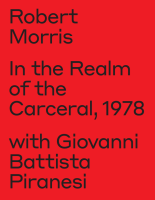In 1978, Robert Morris created a series of twelve black ink drawings titled, In the Realm of the Carceral, showing various details of prison architecture rendered as bold, linear graphics. Castelli Gallery is presenting eight drawings from the series. Alongside these works, the exhibition will include three works from Giovanni Battista Piranesi’s Carceri d’Invenzione, 1745-60, a well-known collection of etchings depicting the dark and labyrinthine interiors of imaginary monumental prisons, examples of which may have fascinated a young Morris visiting the Nelson-Atkins Gallery in his hometown, Kansas City.
Robert Morris emerged as one of the founders of the Minimal Art movement in the 1960s, which revolved around the Green Gallery in New York. He is also known for iconic Felt works, which were first shown at Castelli in 1968.
The 1970s were a decade in which many artists became committed to activism and politics. Morris was at the forefront of this effort, participating in the Art Workers Coalition, a protest group that launched a major critique of public museums’ political inaction and questionable corporate partnerships. Politics influenced Morris’s work as well, which increasingly explored themes of obedience, authority, submission, confinement, subjugation, and disorder.
This turn is clearly illustrated in Morris’s In the Realm of the Carceral, and critics have attributed to the Carceral drawings a threshold moment in Morris’s career. According to Branden Joseph, the Carceral drawings are “the series of works with which Morris’s minimalist project may be said to have ended.” Other writers, however, suggested that the drawings suggest a new way of interpreting the definition of Minimal Art. Regardless of this debate, Morris continued to engage with power, its various articulations in space, and its psychological effects on the viewer for the remainder of his career.
In his own time during the Italian Enlightenment and since, Piranesi is known as an artist whose work forges an interface between reason and imagination, order and feeling. Piranesi’s Carceri infuse his distinctive dramatic vaulted spaces with an alternative impression of Palladian Rome: an imaginary world of psychological and physical horror.
Piranesi’s etchings were also an influence on Michel Foucault’s influential text, Discipline and Punish: The Birth of Prison. Written in 1975 and translated into English in 1977, it is a fundamental book about prison, not only as a place to confine and isolate the body from society, but also as a condition of the mind. It is likely that Morris encountered Foucault’s writing during this time, and these readings may have reminded the artist of his earlier experience with Piranesi’s Carceri etchings, inspiring him to make his own Carceral drawings.
Accompanying this exhibition is an illustrated catalogue featuring an essay by art historian Miguel de Baca.
For more information please contact Broc Blegen at broc@castelligallery.com






